Text

Link to trailer on vimeo.
Natalia Papaeva forgot her mother tongue. Many people in her native Buryatia (Siberia) are losing their language. The Buryat language is one of nearly 2600 languages likely to disappear. Of all 6000 languages in the world, 43% are endangered. In her performance "YOKHOR" (2018) she is singing two sentences from a Buryat traditional song. The only two sentences she remembered. Я бурятка, которая забыла родной язык. Многие люди из Бурятии потеряют свой язык через несколько десятилетий. В своем перформансе я пою только две строчки из традиционной бурятской песни, которые я помню.
3 notes
·
View notes
Text
Abu Hamdan again
In Augustus 2022 I already wrote, here, about my interest in Lawrence Abu Hamdan in whose work art, sound research, language and politics meet. At the end of November my travels brought me to Besançon and I was happy to see the frac Franche-Comté presented an exhibition Aux frontières de l'audible on Abu Hamdan's work. (19/11/2023 - 14/04/2024) The show contains six works of which 45th Parallel from 2022 and Rubber coated steel from 2016 impressed me most.
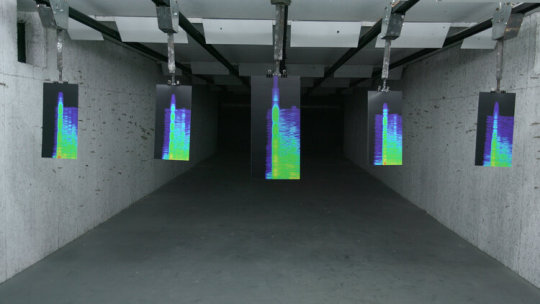
Rubber Coated Steel is the video part (21,47 min.) of the installation Earshot. I watched the total video, absorbed by it's aesthetic and narrational force. It was delicate and needed all my attention. This was thorough sound research, which had political impact, brought as a thrilling video piece. Abu Hamdan questions how civil rights are "heard" today. The facts about the rubber bullets disguising real bullets are here.
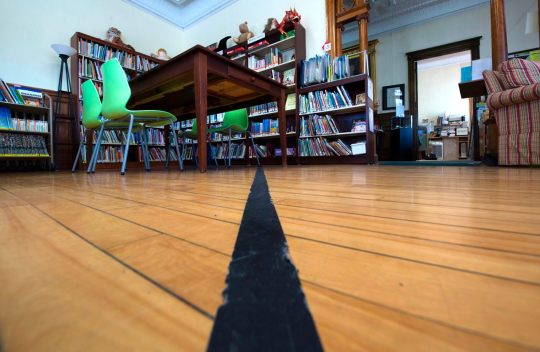
In 45th Parallel, a video (color, sound, 15 min.) and two painted backdrops, the notion of border, often fragile, porous, absurd yet lethal, is narrated as a political and geographical grey zone in the concrete context of the Haskell Free Library and Opera House – a unique municipal site that straddles the jurisdictions of Canada and the United States (see photo of the library). Again, the facts and stories told are impressive, but what touched me especially was how strong and good in Abu Hamdan's work, research and art are entangled. Facts do "speak", but brought this way they "touch" profoundly. :) Art is a language:)
2 notes
·
View notes
Text
Language is a Foreign Language
Language is a Foreign Language / Experimental Translation as Device Nancy Seidler, Hopscotch Translation, 2022.
A good, insightful text on translation and it's role, with well described and nice examples.

Language shapes the way we see. Experimental translation shapes the way we see language. The way we see language shapes the way we construct our selves, the landscapes we inhabit.
i's, land/guage/scape, no original, floating, self/other relation, textual instability, entanglement, Yoko Tawada, enstrangement, Wang Wei, Chantal Wright, Chika Sagawa, Eliot Weinberger, Ezra Pound, Ngũgĩ wa Thiong'o, Octavio Paz, Outranspo, Sawako Nakayasu, Viktor Shklovsky, Xiaolu Guo, Bakhtin
“Is this ich always the same? Can one always be the same?” Her (Yoko Tawada) questions about language have no resolution, “and that’s exciting”. These questions without answers, this paradoxical positioning between languages, is the enstrangement she lives in a multilingual subjecthood.
“Language,” Ngũgĩ wa Thiong’o writes, “is thus mediating between me and my own self; between my own self and other selves; between me and nature. Language is mediating in my very being” (15). The language that allows us to say “I, myself,” is entangled within these frameworks. As Yoko Tawada mused, “I” am not the same “I” in another language.
1 note
·
View note
Text
language is a dynamic social thing
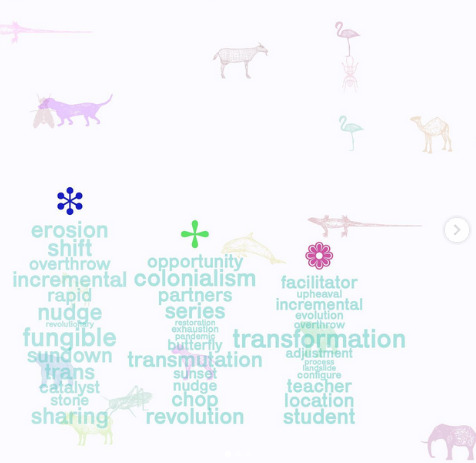
The CreaTures Glossary is a set of tools for giving meaning to a lexicon of terms related to creative practice and transformational change. The Glossary includes games, a website, workshops, and other interactions that facilitate language as a social practice. It aims to give meaning to a lexicon that is particular to the field of creative practice and ecosocial transformation, but which might also work more broadly. Here, language is understood as belonging to no one in particular and to everyone at the same time.
Reference works like dictionaries, glossaries, and thesauri usually give an elite group of experts the authority to assign meanings to words, even though the language is a dynamic social thing.
The Glossary author, artist Amira Hanafi, brings a radical understanding of “common” to the project. They understand language, as part of the commons, as a site where displays of power are continuously produced and contested. Rather than produce fixed definitions, the Glossary distributes power to define language throughout the community or collective that interacts with it.
11 notes
·
View notes
Text
Burroughs was a feminist!
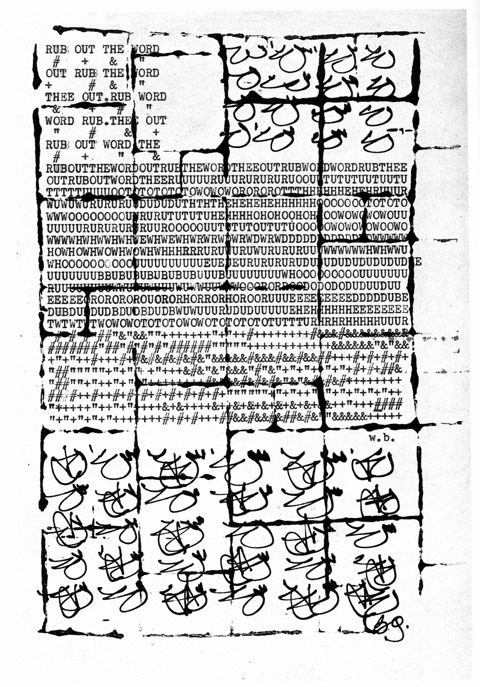
Rub Out The World, drawing by Brion Gysin and William S. Burroughs.
William S. Burroughs tells us how we can scramble the control society through grammar in his essay The Electronic Revolution, from 1970.
delete the copula (is/are), i.e., disrupt fixed identities – YOU ARE WHAT YOU ARE NOT [Lacan]!
replace definite articles (the) with indefinite articles (a/an), i.e., avoid reification — THERE EXIST MULTIPLICITIES [Badiou]!
replace either/or with and, i.e., ignore the law of contradiction — JUXTAPOSE [Silliman]!
1. Copula
The IS OF IDENTITY. You are an animal. You are a body. Now whatever you may be you are not an “animal,” you are not a “body,” because these are verbal labels. The IS of identity always carries the assignment of permanent condition. To stay that way. All name calling presupposes the IS of identity. This concept is unnecessary in a hieroglyphic language like ancient Egyptian and in fact frequently omitted. No need to say the sun IS in the sky, sun in sky suffices. The verb TO BE can easily be omitted from any languages. . . . (“ER” 33)
2. Definite Articles → Indefinite Articles
THE DEFINITE ARTICLE THE. The contains the implication of one and only: THE God, THE universe, THE way, THE right, THE wrong, If there is another, then THAT universe, THAT way is no longer THE universe, THE way. The definite article THE will be deleted and the indefinite article A will take its place. (33-34)
3. Either/Or → And
THE WHOLE CONCEPT OF EITHER/OR. Right or wrong, physical or mental, true or false, the whole concept of or will be deleted from the language and replaced by juxtaposition, by AND. This is done to some extent in any pictorial language where two concepts stand literally side by side. (ibid.)
Via Burroughs on How to Escape the Society of Control by Sean Kohingarara Sturm, 2010.
#control society#Sean Kohingarara Sturm#william s. burroughs#the electronic revolution#scrambling language#feminism
10 notes
·
View notes
Text
Dutch or English arts critics?
art (discourse) for who? opposing demands: use English to be international - use Dutch to be understood be the general public
GL: As is the case in many non-English speaking countries, art criticism in the Netherlands is caught in the dilemma of whether it is obliged to communicate in the national language to reach its own audiences or submit to the pressure to participate in the global conversations, in English. In the past, when there was still plenty of money, it was easy to declare that we do both, but these days there is less and less money for translations, and for publications in general. Publishing websites are supposed to produce their content, in English, for free. Do you see in these conditions a necessity to return to Dutch in order to restore support for the arts in society without reverting to the national (or nationalist) frame of reference? Hasn’t the widespread use of English contributed to the gap between subjectivity and culture, and instead of a solution has become a problem? Should we in fact conduct this interview in Dutch? MO: I don’t think it’s very productive to tell people what language they should write in. But the gap is increasingly problematic. And Dutch institutions do prescribe the use of English. For example, Dutch academics are rewarded three times as much for English articles as for Dutch ones. Publishing books in Dutch is considered a hobby, something to do in your leisure time. This has an effect on Dutch intellectual culture. It is basically living apart together. The general audience reads in Dutch and lives in another world, intellectually. That broader Dutch audience is mostly served by journalists, who tend to be more superficial and more conservative. ... A critical art practice needs to take into account the conditions of its own intelligibility. If curators, critics and artists won’t relate to the Dutch public in the Dutch language, someone else will do it for you. And on the long term, that will result in a very hostile climate.
Merijn Oudenampsen on the Hermetic Contemporary Arts Discourse by Geert Lovink. Interview from 2016.
#geert lovink#Merijn Oudenampsen#contemporary arts discourse#language and society#critical art practice#interview
2 notes
·
View notes
Text
En Un Momento Dado
Johan Cruyff (Amsterdam, 1947-Barcelona, 2016), was a famous Dutch football player, coach and sports entrepreneur. In 2004 Ramón Gieling made a documentary with the title: Op een gegeven moment / En Un Momento Dado, on the period he played for FC Barcelona.
youtube
Op een gegeven moment means “at a certain point”, by litteraly translating it to en un momento dado Cruijff created a “new” Spanish expression, that entered Spanish daily conversations. Through the use of “dado” (”given”, by whom?, God?) the moment, meant in the expression, became really special. Btw the correct translation would have been “en cualquier momento".
Cruijff has always been a creative communicator and left the Dutch and Spanish language with interesting expressions, that entered the official dictionaries of these languages.
Spanish and Dutch authors have analysed the construction of his speech. Paradoxes that led to a deeper insight such as "every disadvantage has its advantage" as a starting point to take the positive out of a setback or defeat, tautologies and pleonasms, neologisms, crossings of English, Spanish and Dutch expressions such as "en un momento dado” instead of “en cualquier momento", creation of lapidary sentences in imitation of his coach at Ajax and F. C. Barcelona Rinus Michels such as "chance is logic" to express that you have to do what you have to do and that there are no coincidences, catchphrases, pronouns in the first person plural and the use of usted to refer to himself, changes in the gender of words and modification of expressions such as “gallina de piel” (kippenvel?), ... His permanent verbal transgression probably reflected the profound logic that separates the real from the ideal and the different speed between innovative football thinking - aimed at the football establishment - and the difficulty of expressing it correctly in a language given the multilingual life in which professional footballers' careers unfold. It points to the predominance of the power of communication over the form of language in shaping concepts that escape evidence, or in passing judgement.
Translated with www.DeepL.com/Translator from Johan Cruyff: la renovación 14 by Jesús Castañón Rodríguez
#Johan Cruyff#Jesús Castañón Rodríguez#en un momento dado#multilingualism#football#language renewal#Ramón Gieling#op eeen gegeven moment
1 note
·
View note
Text
Shibboleth
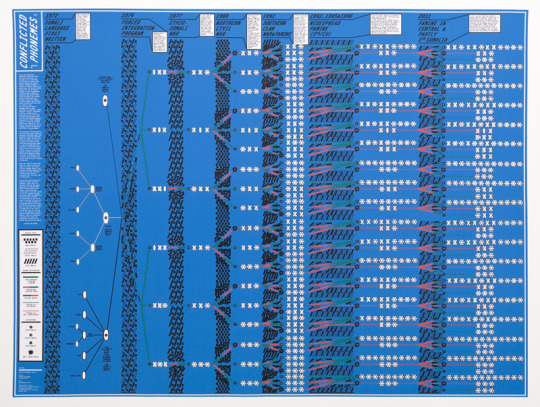
Conflicted Phonemes, 2012, Lawrence Abu Hamdan with graphic designer Janna Ullrich.
Lawrence Abu Hamdan is an independent investigator or Private Ear with a great interest in the political use of sound and linguistics.
Conflicted Phonemes is made of vinyl wall prints and takeaway printed A4 sheets on a shelf. The prints visualize the complex relation between a person’s place of birth and linguistic identity, whilst also examining how itinerant and precarious social conditions and cultural exchange result in a hybridization of accents, thus questioning the efficacy of forensic technologies and practices of “bordering” conducted by Dutch immigration authorities.
I wish I could experience this work and the follow-up, also from 2012, The Freedom of Speech focusing on the UK’s controversial use of voice analysis to determine the origins and authenticity of asylum seekers’ accents. The Freedom of Speech is a mixed-media installation comprising a stereo audio documentary and an acoustic foam sculpture on the geopolitics of accents and listening practices that have led to shocking stories of wrongful deportations.
Judges 12:5-6 English Standard Version: they said to him, “Then say Shibboleth,” and he said, “Sibboleth,” for he could not pronounce it right. Then they seized him and slaughtered him at the fords of the Jordan. At that time 42,000 of the Ephraimites fell.
There are lots of articles on Abu Hamdan’s work. Here just one written by Emily Apter : Shibboleth: Policing by Ear and Forensic Listening in Projects by Lawrence Abu Hamdan, 2016 October Magazine, Ltd. and Massachusetts Institute of Technology, https://doi.org/10.1162/OCTO_a_00253
Abstract: Drawing on the work of Lawrence Abu Hamdan, a British-Lebanese artist and researcher currently based in Beirut, this essay examines the juridical and conceptual field of critical forensis which is situated at the juncture of security studies, art, and architecture. Abu Hamdan extends forensics to the area of “new audibilities,” with a focus on the politics of juridical hearing in situations of legal-identity profiling and voice authentication (the “shibboleth test”). Abu Hamdan's projects investigate how accent monitoring and audio surveillance, voice recognition, translation technologies, sovereign acts of listening, and court determinations of linguistic norms emerge as so many technical constraints on “freedom of speech,” itself a malleable term ascribed to discrepant claims and principles, yet taking on performative force in site-specific situations.
#Lawrence Abu Hamdan#new audibilities#Shibboleth#voice analysis#bordering#forensic technologies#art#policing#immigration
3 notes
·
View notes
Text
auto-traduction self-translation
A friend, quand je lui parle de l’auto-traduction m’écrit : j'entends à la radio ce matin que Nabokov avait voulu traduire lui-même son livre Lolita de l'anglais au russe et que cette traduction n'est pas une belle traduction selon l'écrivain Makine, écrivain d'origine russe admis à l'académie française, car pleine d'anglicismes. Ne pas belle, vraiment? J’ai du mal d’y croire. Je n’y crois pas. Wouldn’t it be possible that Nabokov played with the performative space of what Lily Robert-Foley called the Third Text?
Clichés et auto-traduction chez Vladimir Nabokov et Samuel Beckett, Michaël Oustinoff, Palimpsestes, 13 | 2001, 109-128.
Résumé: L’auto-traduction n’est nullement un aspect marginal des œuvres de Nabokov ou de Beckett : elle en constitue une part essentielle, notamment au regard des libertés dont dispose un auteur se traduisant lui-même. On ne s’étonnera donc pas de voir Nabokov et Beckett poursuivre le travail de l’écriture au travers de la traduction : les clichés, partie intégrante de leur style, sont souvent soumis à toutes sortes de transformations créatrices, comme lorsque Beckett traduit “je n’ai rien contre les cimetières” par “I have no bone to pick with graveyards”, montrant ainsi comment le télescopage des clichés peut faire naître une formulation neuve. Il ne faudrait cependant pas en conclure que la traduction proprement dite est, par contraste, nécessairement déficiente. C’est l’inverse qui est vrai : il suffit de voir dans la traduction du Ulysses de James Joyce les cliches se répondre avec bonheur d’une langue à l’autre pour se convaincre que traduction et auto-traduction relèvent en réalité d’un même domaine, celui de la poétique.
Wastes and wilds of the Third Text, a roving topos between Samuel Beckett’s self-translations of L’Innommable and The Unnamable, Lily Robert-Foley, Eu-topias, 2016.
Abstract: Using the theoretical tools of reflections on self-translation and the heritage of Deconstruction and Postcolonial thinking, this article strives to deform discourse surrounding a canonical author. It constructs a third text in-between the self-translation of Samuel Beckett’s The Unnamable and L’Innommable. The third text is a performative space, where reading takes immediate form in its rewriting, its transformation. It creates new syntagms, figures, stories and themes in the transport routes shared by translation and metaphor. After a brief look at work on self-translation, specifically in Beckett, the article attempts to deconstruct theory with practice, reading (and thus rewriting) translations of the same, instances of self-allegory, and figures of displacement in time and space.
#Michaël Oustinoff#beckett#nabokov#lily robert-foley#the third text#self-translation#auto-traduction
0 notes
Text
Algorithmic politics

This is an image of the second itteration of the project “El 27 | The 27th” (originally from 2014) by Eugenio Tisselli, a programmer, writer and researcher. In this piece each time the New York Stock Exchange Composite Index closes with a positive percent variation, a fragment of the 27th article of the Mexican Constitution, written in Spanish, is automatically translated into English.
The piece materialises in a “poetic” way, the devasting processes - from necropolics to necrocapitalism - going on in Eugenio’s homeland. He explains its context in Article 27: Algorithmic politics published on Furtherfield:
Today, the dictatorship of finance prescribes a progressive and quick reduction of the sphere of politics, with the aim of canceling the restrictions that laws and codes used to impose on the flow of capital. And governments have indeed shrunk, turning thus into little more than facilitators of the unstoppable progress of capitalism.
Given enough time, the algorithm will produce a version of Article 27 fully readable in an effective – yet incorrect – English. An automated English that will already have attempted to displace humans brutally, even though they might still be fighting for a territory delimited by language only, and refusing to die. An automated English that will have already eroded a land delimited by language only, rendering it unrecognizable: torn, exploited, almost dead.
#Eugenio Tisselli#article 27 of the Mexican Constitution#translation#algorithmic politics#^NYA#automated English#necrocapitalism#poetry
3 notes
·
View notes
Link
“ قلب is a programming language written entirely in Arabic by Lebanese-born computer scientist Ramsey Nasser in 2013. قلب (transliterated and pronounced as Alb in Nasser's native Levantine Spoken Arabic), is a Scheme-based conceptual art piece designed to challenge the anglocentric nature of computer science.”
“In order to see how queer culture could interact with software platforms, Blas told me, it was necessary to use an alternative logical basis—to reject programming in its current form and reimagine it from the bottom up.“
“Software engineering consists of one agent (the programmer) giving commands, and another (the computer) receiving and, unless there's an error, obeying them.“ Ari Schlesinger.
“We’re becoming a little hesitant to call programming a universal medium, and that’s what I’d hoped for.” Nasser Julianne Tveten, Vice Motherboard 2016.
0 notes
Text
Ubykh and Wymysorys
youtube
Short extract from The Last Silent Movie by Susan Hiller, 2007/2008.
I wish I could see this movie. I wish I could hear these lost tongues (most people who speak in the movie are now dead). Hiller also made 24 etchings based on oscilloscope traces of the voices heard in the movie.

Ubykh, plate 21 from The Last Silent Movie.
Tevfik Esenç (1904 – 7 October 1992) a Circassian exile in Turkey was the last known fully competent speaker of the Ubykh language, that had one of the largest inventories of consonants (84) in the world. Ubykh was sadly destroyed / forbidden during the 100-year Russian-Circassian War. Here you can hear him tell a story in Ubykh.
youtube
Languages often disappear after / in conflicts through colonialisation and nowadays because of globalisation.
Sometimes disappearing tongues can be rescued. Tymoteusz Król started revitalisation efforts for Wymysorys a West Germanic language spoken by the ethnic Vilamovian minority in the small town of Wilamowice, Poland. He compiled language records, standardised the written orthography and made a dictionary. Moreover he gave private lessons to young children in Wilamowice and founded a theater- and folk group. It seems to be a succes: pop songs and children books now exist in Wymysorys. “Śłöf maj buwła fest! Skumma fremdy gest,“
youtube
0 notes
Text
kereta api again
How our brains cope with speaking more than one language by Nicole Chang.
Years ago in Italy I asked, after exercising for at least 5 min. how to ask for a train, I said: Domani kereta api per Firenza? instead of Da domani un treno per Firenze? In my brain my very rudimentary (in fact unexisting) Italian had mixed with my also very rudimentary Indonesian.
The inhibition system in my brain failed and produced a slip-up.
Tamar Gollan, a professor of psychiatry at the University of California San Diego, has been studying language control in bilinguals for years.
I think maybe one of the most unique things that we've seen in bilinguals when they're mixing languages is that sometimes, it seems like they inhibit the dominant language so much that they actually are slower to speak in certain contexts, she says.
And even though the majority of participants were dominant English speakers, they made more of these intrusion errors for words in English rather than their weaker Spanish – something that Gollan explains is almost like a reversal of language dominance.
Our languages aren't just static throughout our lives but shifting, actively competing and interfering with each other.
Immersing yourself in a foreign language is often the best way to learn it, but it can come at the temporary cost of your native tongue.
0 notes
Text
accents - poetry - immigration
“If you ask me if I am fluent in Spanish, I will tell you that my Spanish is an itchy phantom limb; it is reaching for words and only finding air.” Melissa Lozada-Oliva.
youtube
"The Bridge," George Masao Yamazawa, the son of Japanese immigrants, captured the identity crises many immigrants face.
youtube
1 note
·
View note
Text
dementia & monolinguism
- those who spoke two languages developed dementia an average of four and a half years later than the monolinguals -
Bilingualism delays age at onset of dementia, independent of education and immigration status, Suvarna Alladi, Thomas H. Bak, Vasanta Duggirala, Bapiraju Surampudi, Mekala Shailaja, Anuj Kumar Shukla, Jaydip Ray Chaudhuri, Subhash Kaul, American Academy of Neurology, Nov 6 2013.
This article triggered some discussion but it seems that further research confirms the original article. See Disputes & Debates.
0 notes
Text
Voicing and Rub-up’s.
How can we (re)conceive and engage with non-verbal forms of language and communication in our verbal being?
This is the basic and interesting question Imogen Stidworthy asks in her 153 pages long dissertation Voicing on the borders of language from 2020 at the Faculty of Fine and Performing Arts, Lund University, Sweden. Something to read!

Related interesting passages found in Detours, e-flux Journal #115 - February 2021.
Glossary: “Voicing”: In encounters between people, different forms of language communication may be happening, but we cannot be certain. What we take for a voice may not in fact be a form of address at all. (“He missed the voice, or the voice missed him.” – Fernand Deligny). Or a voice may take a form that we do not recognize as a voice. To engage with different forms of language means widening our scope of attention to different registers, so that voicing includes speech sounds and sonic utterances, but also somatic registers of bodily gesture and movement, rhythms, spatial and temporal forms, imperceptible vibrations, and silences. Voicing: “calling forth” in the impulse to mobilize oneself towards another or to “me.” Glossary: “Rub-up”: The rub-up is what is produced in encounters between people who voice themselves through different forms of language. Bewilderment, energy, friction, heat, intimacy—the rub-up arises in grappling with unfamiliar terms, in not understanding. When language reaches its limits, our relationship with it is exposed in new ways, and in this sense the rub-up is inherently reflexive. In these conditions we learn to attune to different registers of voicing around and beyond our own, broadening the scope of communication. Losing a sense of bodily boundaries can happen when we are dancing, attuned to another person, or immersed in nature. Many people on the spectrum describe intense feelings of a “leaky sense of self”: becoming confused with other people or with one’s surroundings, losing or having no sense of being “me,” in ways that can sometimes be existentially threatening, but also exhilarating, liberating, and joyful. Different forms of voicing call me to listen with all the senses, because when I engage with a language I do not know, I do not know what I am listening for.
1 note
·
View note
Text
Muttersprache und Mördersprache

The German language, Celan often said, was his mother’s tongue and the tongue of her murderers (‘Muttersprache und Mördersprache’). Writing poetry in German was for him both an act of remembrance and a rescue mission, as if a language could and could not be saved from its historical contamination.
Found in Arnon Grunberg’s blog entry Murderers Tongue, where he cites Michael Wood’s article This happens every day, on Paul Celan’s poetry.
‘We are strangers’, the short poem called ‘Sprachgitter’ asserts. We are ‘mouthfuls of silence’ even when we speak, especially when we speak. But there is that light between the bars, and there is that guess. If we start as modestly, as unfiguratively, as possible, we may after all get somewhere, find some snowy connection between ourselves and others.
Next time I will adjust my litanie on e-strangers: I speak a broken tongue, my tongue is bastard, wobbly, twisted, turned, tortoise, torte, tortuous and murderous? from with/in languages – a pretty pathetic, ISSN électronique 2276-3538.
1 note
·
View note